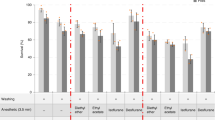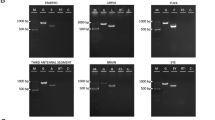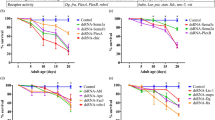Abstract
There is growing interest in the link between axonal cargo transport and age-associated neuronal dysfunction. The study of axonal transport in neurons of adult animals requires intravital or ex vivo imaging approaches, which are laborious and expensive in vertebrate models. We describe simple, noninvasive procedures for imaging cargo motility within axons using sensory neurons of the translucent Drosophila wing. A key aspect is a method for mounting the intact fly that allows detailed imaging of transport in wing neurons. Coupled with existing genetic tools in Drosophila, this is a tractable system for studying axonal transport over the life span of an animal and thus for characterization of the relationship between cargo dynamics, neuronal aging and disease. Preparation of a sample for imaging takes ∼5 min, with transport typically filmed for 2–3 min per wing. We also document procedures for the quantification of transport parameters from the acquired images and describe how the protocol can be adapted to study other cell biological processes in aging neurons.
This is a preview of subscription content, access via your institution
Access options
Subscribe to this journal
Receive 12 print issues and online access
$259.00 per year
only $21.58 per issue
Buy this article
- Purchase on Springer Link
- Instant access to full article PDF
Prices may be subject to local taxes which are calculated during checkout





Similar content being viewed by others
References
Millecamps, S. & Julien, J.-P. Axonal transport deficits and neurodegenerative diseases. Nat. Rev. Neurosci. 14, 161–176 (2013).
Misgeld, T., Kerschensteiner, M., Bareyre, F.M., Burgess, R.W. & Lichtman, J.W. Imaging axonal transport of mitochondria in vivo. Nat. Methods 4, 559–561 (2007).
Sajic, M. et al. Impulse conduction increases mitochondrial transport in adult mammalian peripheral nerves in vivo. PLoS Biol. 11, e1001754 (2013).
Gibbs, K.L., Kalmar, B., Sleigh, J.N., Greensmith, L. & Schiavo, G. In vivo imaging of axonal transport in murine motor and sensory neurons. J. Neurosci. Methods 257, 26–33 (2016).
Takihara, Y. et al. In vivo imaging of axonal transport of mitochondria in the diseased and aged mammalian CNS. Proc. Natl. Acad. Sci. USA 112, 10515–10520 (2015).
Milde, S., Adalbert, R., Elaman, M.H. & Coleman, M.P. Axonal transport declines with age in two distinct phases separated by a period of relative stability. Neurobiol. Aging 36, 971–981 (2015).
Rao, S., Lang, C., Levitan, E.S. & Deitcher, D.L. Visualization of neuropeptide expression, transport, and exocytosis in Drosophila melanogaster. J. Neurobiol. 49, 159–172 (2001).
Gunawardena, S. et al. Disruption of axonal transport by loss of huntingtin or expression of pathogenic polyQ proteins in Drosophila. Neuron 40, 25–40 (2003).
Pilling, A.D., Horiuchi, D., Lively, C.M. & Saxton, W.M. Kinesin-1 and dynein are the primary motors for fast transport of mitochondria in Drosophila motor axons. Mol. Biol. Cell 17, 2057–2068 (2006).
Fang, Y., Soares, L., Teng, X., Geary, M. & Bonini, N.M. A novel Drosophila model of nerve injury reveals an essential role of Nmnat in maintaining axonal integrity. Curr. Biol. 22, 590–595 (2012).
Fang, Y., Soares, L. & Bonini, N.M. Design and implementation of in vivo imaging of neural injury responses in the adult Drosophila wing. Nat. Protoc. 8, 810–819 (2013).
Neukomm, L.J., Burdett, T.C., Gonzalez, M.A., Züchner, S. & Freeman, M.R. Rapid in vivo forward genetic approach for identifying axon death genes in Drosophila. Proc. Natl. Acad. Sci. USA 111, 9965–9970 (2014).
Whitlock, K.E. & Palka, J. Development of wing sensory axons in the central nervous system of Drosophila during metamorphosis. J. Neurobiol. 26, 189–204 (1995).
Nakamura, M., Baldwin, D., Hannaford, S., Palka, J. & Montell, C. Defective proboscis extension response (DPR), a member of the Ig superfamily required for the gustatory response to salt. J. Neurosci. 22, 3463–3472 (2002).
Fang, Y. & Bonini, N.M. Hope on the (fruit) fly: the Drosophila wing paradigm of axon injury. Neural Regen. Res. 10, 173–175 (2015).
Soares, L., Parisi, M. & Bonini, N.M. Axon injury and regeneration in the adult Drosophila. Sci. Rep. 4, 6199 (2014).
Cassimeris, L.U., Wadsworth, P. & Salmon, E.D. Dynamics of microtubule depolymerization in monocytes. J. Cell Biol. 102, 2023–2032 (1986).
Fygenson, D., Braun, E. & Libchaber, A. Phase diagram of microtubules. Phys. Rev. E Stat. Phys. Plasmas Fluids Relat. Interdiscip. Topics 50, 1579–1588 (1994).
Brand, A.H. & Perrimon, N. Targeted gene expression as a means of altering cell fates and generating dominant phenotypes. Development 118, 401–415 (1993).
Lai, S.-L. & Lee, T. Genetic mosaic with dual binary transcriptional systems in Drosophila. Nat. Neurosci. 9, 703–709 (2006).
Vagnoni, A., Hoffmann, P.C. & Bullock, S.L. Reducing Lissencephaly-1 levels augments mitochondrial transport and has a protective effect in adult Drosophila neurons. J. Cell Sci. 129, 178–190 (2016).
Port, F., Chen, H.-M., Lee, T. & Bullock, S.L. Optimized CRISPR/Cas tools for efficient germline and somatic genome engineering in Drosophila. Proc. Natl. Acad. Sci. USA 111, E2967–E2076 (2014).
Xu, J. et al. A toolkit of CRISPR-based genome editing systems in Drosophila. J. Genet. Genomics 42, 141–149 (2015).
Dietzl, G. et al. A genome-wide transgenic RNAi library for conditional gene inactivation in Drosophila. Nature 448, 151–156 (2007).
Ni, J.Q. et al. A Drosophila resource of transgenic RNAi lines for neurogenetics. Genetics 182, 1089–1100 (2009).
Suster, M.L., Seugnet, L., Bate, M. & Sokolowski, M.B. Refining GAL4-driven transgene expression in Drosophila with a GAL80 enhancer-trap. Genesis 39, 240–245 (2004).
Pfeiffer, B.D. et al. Refinement of tools for targeted gene expression in Drosophila. Genetics 186, 735–755 (2010).
Chen, T.-W. et al. Ultrasensitive fluorescent proteins for imaging neuronal activity. Nature 499, 295–300 (2013).
Dana, H. et al. Sensitive red protein calcium indicators for imaging neural activity. eLife 5, e12727 (2016).
Valmalette, J.C. et al. Nano-architecture of gustatory chemosensory bristles and trachea in Drosophila wings. Sci. Rep. 5, 14198 (2015).
Albrecht, S.C., Barata, A.G., Grosshans, J., Teleman, A.A. & Dick, T.P. In vivo mapping of hydrogen peroxide and oxidized glutathione reveals chemical and regional specificity of redox homeostasis. Cell Metab. 14, 819–829 (2011).
Chatterjee, N. & Bohmann, D. A versatile ΦC31 based reporter system for measuring AP-1 and Nrf2 signaling in Drosophila and in tissue culture. PLoS One 7, e34063 (2012).
Reis, G.F. et al. Molecular motor function in axonal transport in vivo probed by genetic and computational analysis in Drosophila. Mol. Biol. Cell 23, 1700–1714 (2012).
Chenouard, N. et al. Objective comparison of particle tracking methods. Nat. Methods 11, 281–289 (2014).
Bros, E., Hauser, A., Paul, F., Niesner, R. & Infante-Duarte, C. Assessing mitochondrial movement within neurons: manual versus automated tracking methods. Traffic 16, 906–917 (2015).
Nagarkar-Jaiswal, S. et al. A genetic toolkit for tagging intronic MiMIC containing genes. eLife 4, e08469 (2015).
Parton, R.M., Vallés, A.M., Dobbie, I.M. & Davis, I. Isolation of Drosophila egg chambers for imaging. Cold Spring Harb. Protoc. 2010 10.1101/pdb.prot5402 (2010).
Meijering, E., Dzyubachyk, O. & Smal, I. Methods for cell and particle tracking. Methods Enzymol. 504, 183–200 (2012).
Chatzigeorgiou, M., Bang, S., Hwang, S.W. & Schafer, W.R. tmc-1 encodes a sodium-sensitive channel required for salt chemosensation in C. elegans. Nature 494, 95–99 (2013).
Torroja, L., Chu, H., Kotovsky, I. & White, K. Neuronal overexpression of APPL, the Drosophila homologue of the amyloid precursor protein (APP), disrupts axonal transport. Curr. Biol. 9, 489–493 (1999).
Lin, D.M. & Goodman, C.S. Ectopic and increased expression of fasciclin II alters motoneuron growth cone guidance. Neuron 13, 507–523 (1994).
Mahr, A. & Aberle, H. The expression pattern of the Drosophila vesicular glutamate transporter: a marker protein for motoneurons and glutamatergic centers in the brain. Gene Expr. Patterns 6, 299–309 (2006).
Pfeiffer, B.D., Truman, J.W. & Rubin, G.M. Using translational enhancers to increase transgene expression in Drosophila. Proc. Natl. Acad. Sci. USA 109, 6626–6631 (2012).
Fabrowski, P. et al. Tubular endocytosis drives remodelling of the apical surface during epithelial morphogenesis in Drosophila. Nat. Commun. 4, 2244 (2013).
Akerboom, J. et al. Optimization of a GCaMP calcium indicator for neural activity imaging. J. Neurosci. 32, 13819–13840 (2012).
Halfon, M.S. et al. New fluorescent protein reporters for use with the Drosophila Gal4 expression system and for vital detection of balancer chromosomes. Genesis 34, 135–138 (2002).
Lee, T. & Luo, L. Mosaic analysis with a repressible cell marker for studies of gene function in neuronal morphogenesis. Neuron 22, 451–461 (1999).
Petersen, L.K. & Stowers, R.S. A gateway multiSite recombination cloning toolkit. PLoS One 6, e24531 (2011).
Han, C., Jan, L.Y. & Jan, Y.-N. Enhancer-driven membrane markers for analysis of nonautonomous mechanisms reveal neuron-glia interactions in Drosophila. Proc. Natl. Acad. Sci. USA 108, 9673–9678 (2011).
Yang, W.-K. et al. Nak regulates localization of clathrin sites in higher-order dendrites to promote local dendrite growth. Neuron 72, 285–299 (2011).
Barolo, S., Castro, B. & Posakony, J.W. New Drosophila transgenic reporters: insulated P-element vectors expressing fast-maturing RFP. Biotechniques 36, 436–442 (2004).
McGuire, S.E., Le, P.T., Osborn, A.J., Matsumoto, K. & Davis, R.L. Spatiotemporal rescue of memory dysfunction in Drosophila. Science 302, 1765–1768 (2003).
Acknowledgements
We are grateful to the LMB Media Kitchen for fly food preparation, N. Grant from LMB Visual Aids for help with Figure 3 and Supplementary Video 1, M. Pasche (MRC-LMB) for assistance with the SIM experiments, and D. Brunner (University of Zurich, Switzerland), G. Jefferis (MRC-LMB, UK), A. Whitworth (MRC Mitochondrial Biology Unit, UK) and the Bloomington Drosophila Stock Center (Indiana University) for sharing fly stocks. The development of this protocol was supported by funding to S.L.B. from the UK Medical Research Council (MRC file reference number MC_U105178790). A.V. is the recipient of an NC3Rs David Sainsbury Fellowship (NC/N001753/1).
Author information
Authors and Affiliations
Contributions
A.V. and S.L.B. conceived the study. A.V. and S.L.B. designed the experiments. A.V. performed the experiments and collected the data. A.V. and S.L.B. wrote the manuscript.
Corresponding authors
Ethics declarations
Competing interests
The authors declare no competing financial interests.
Integrated supplementary information
Supplementary Figure 1 Assessment of the effects of CO2 exposure on cargo transport.
Quantification of the number of total mitochondria that are motile in dpr+ wing neurons in a 3 min time window when flies are exposed to CO2 for 5 min followed by mounting and immediate imaging (CO2 – long) or exposed to CO2 for 20–30 s followed by mounting and a ~ 5 min recovery period before imaging (CO2 – short). Bar shows mean ± standard error of the mean, with values for each movie shown as magenta circles. For each parameter, there was no statistically significant difference between the two conditions.
Supplementary Figure 2 Structured illumination microscopy (SIM) of L1 vein neurons.
Representative SIM image of the anterior wing margin showing cell bodies and processes of neurons in the L1 vein. Wings were mounted using the procedures described in this article. The genotype of the fly is Appl-Gal4>mCD8::GFP, RedStinger::NLS, which leads to cell membranes and nuclei marked in green and red, respectively. Arrowheads, dendrites; arrows, bundled axons. Note the improved detail in the SIM image compared to the image taken by spinning disk microscopy of the same genotype (Fig. 1b). The image is a projection of a z-stack taken on a Zeiss Elyra imaging system using a 63 1.4 NA PlanApo oil-immersion objective. Scale bar: 5 μm.
Supplementary information
Supplementary Text and Figures
Supplementary Figures 1 and 2 (PDF 238 kb)
Movie capturing the procedure used to mount a fly in the imaging chamber (Steps 8–19), with the chamber partially assembled in advance).
Note that the movie does not show the process of inspecting wings for damage or the whole anesthetization procedure. (MOV 24868 kb)
Representative time-lapse movie of mitochondrial dynamics in axons of dpr+ neurons in the wing arch (L1 vein) at 1 day after eclosion.
The cell body is to the left and the thorax to the right in this and other movies. Note that, as in many other neuronal cell types, a significant fraction of mitochondria are stationary at any one time point. Genotype: dpr-Gal4 UAS-mito::GFP. Width: 50 μm. Movie represents 3 min of real time. (MOV 1154 kb)
Representative time-lapse movie of mitochondrial dynamics in axons of nSyb+ neurons in the L3 vein at 2 days after eclosion.
Genotype: nSyb-lexAlexAop- mCherry::mito. Width: 50 μm. Movie represents 3 min of real-time. (MOV 1177 kb)
Time-lapse movie showing an example of mitochondrial fission in axons of dpr+ neurons in the wing arch.
A stationary mitochondrion (red arrow) undergoes fission to produce a new mitochondrion (yellow arrow) that is motile. Genotype: dpr-Gal4 UAS- mito::GFP. Width: 17 μm. Movie represents 68 s of real time. (MOV 59 kb)
Time-lapse movie showing an example of mitochondrial fusion in axons of dpr+ neurons in the wing arch.
A motile mitochondrion (red arrow) undergoes fusion with a stationary mitochondrion (yellow arrow). The orange arrow marks the movement of the new elongated mitochondrion produced by the fusion event. Genotype: dpr-Gal4 UAS- mito: GFP. Width: 50 μm. Movie represents 266 s of real time. (MOV 275 kb)
Representative time-lapse movie of ANF::EMD dynamics in axons of dpr+ neurons in the wing arch at 2 days after eclosion.
The ANF: EMD signal on dense-core vesicles is masked by cytoplasmic GFP encoded by a UAS-GFP transgene on the dpr-Gal4 chromosome. Genotype: dpr-Gal4 UAS-ANF: EMD. Width: 50 μm. Movie represents 1 min of real time. (MOV 191 kb)
Representative time-lapse movie of ANF::EMD dynamics in axons of Appl+ neurons in the wing arch at 2 days after eclosion.
This genotype allows dense-core vesicles to be visualized clearly. Genotype: Appl-Gal4 UAS-ANF: GFP. Width: 50 μm. Movie represents 2 min of real time. (MOV 821 kb)
Representative time-lapse movie of Rab4: RFP dynamics in axons of dpr+ neurons in the wing arch at 2 days after eclosion.
Genotype: dpr-Gal4UAS-Rab4: RFP. Width: 50 μm. Movie represents 1 min of real time. (MOV 543 kb)
Rights and permissions
About this article
Cite this article
Vagnoni, A., Bullock, S. A simple method for imaging axonal transport in aging neurons using the adult Drosophila wing. Nat Protoc 11, 1711–1723 (2016). https://doi.org/10.1038/nprot.2016.112
Published:
Issue Date:
DOI: https://doi.org/10.1038/nprot.2016.112
Comments
By submitting a comment you agree to abide by our Terms and Community Guidelines. If you find something abusive or that does not comply with our terms or guidelines please flag it as inappropriate.



